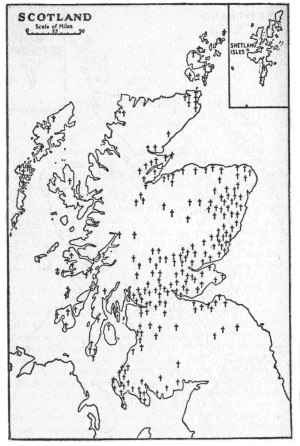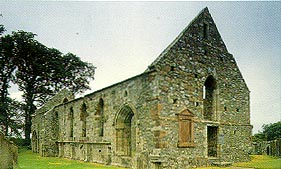Main Content
St Ninian - First Apostle of the Picts
It is one of the greatest matters of shame that the proud Scottish nation is so ignorant of the real identity of the first Apostle to its lands, especially when one considers that he was a son of the soil and not a foreigner. When asked who was the first apostle to the ancient peoples of this country many would give the name of St Columba (Colum Cille) and in so doing would be responsible for the continuation of a grave mistake of which we should be horribly ashamed! These lands were brought the message of the Gospels long before Colum Cille had even been born! Now this is in no way an attempt to try to diminish that holy man's labours and it is very right and proper that we should remember him also with great veneration. But surely we should be even quicker to remember the great Ninian, the first apostle to these lands, and, unlike Columba, a native. What follows here is the 'traditional' version of the story of this Saint's life but, there is now a strong thread of scholarship that identifies Ninian as being one and the same person as St Finnan of Movilla. We would urge the reader to consider the work of Dr Thomas O. Clancy before reaching any conclusions about this saint.1
God chose no ordinary man to sound the trumpet at the advent of Christianity among the northern Brythonic peoples. St Ninian was a worthy and distinguished teacher in the mould of his own spiritual teachers - having been taught by St Martin of Tours, himself a pupil of the legendary St Hilary. With a superb surety of spirit St Ninian brought the message of the Gospels to the Brythonic peoples - his own people, he having been born a Briton in about 362AD to parents of a tribe thought to have inhabited the area near the Soloway Firth. Not only was he ardent in his missionary work but his foundation at Whithorn, the famous Candida Casa, soon became a renowned centre of learning - one to rival any other in the Christian World. From within its walls many were trained who later went into the missionary field to become famous apostles of both Ireland and Alba, even as far north as the misty Orkney and Shetland Islands. Well does Ninian deserve the title, "First Apostle of the Picts and Britons".

Above: Some of the Churches founded before St Columba's time.
Prior to St Ninian's time, there were Christians already within these Brythonic lands, resulting from contact with the small number of Christians who followed in the 'train' of the Roman Legions. Ninian's parents are supposed to have been amongst these Christians. Having been baptised as a boy he later, when a young man, decided to visit Rome where he is said to have studied for many years. When he determined to return to his homelands, Ailred says that the Bishop of Rome consecrated him a bishop.2 On his way home, Ninian stayed with St Martin, Bishop of Tours, and from this soldier-saint, a Christian leader of heroic proportions, he learned the methods and drank from the fountain of inspiration - experiences which dominated the remainder of his own life.
North Britain (present-day Scotland), in the time of St Ninian, was inhabited by a simpler population than it later had. True, there were sporadic Teutonic raiders on the south-east coast, but the large-scale invasions of the Angles and their kindred peoples did not take place till after 449AD. There were also occasional raids on the south-west coast by Scotii from Ireland, but the first major settlement of Scots in North Britain is dated to about 498AD. North Britain, as it presented itself to St Ninian, was to some extent divided by the Forth-Clyde line; north of it were the Picts, south of it the Brythons who occupied the country right to the English Channel. These Picts and Brythons were both Celtic peoples and spoke languages that were similar enough that each could understand the other with relative ease. However, the Pictish tribes were a different matter in that they had their own language which was very different to that of the 'southerners'. We should remind ourselves here that all of this activity took place one hundred and fifty years before St Columba's time. There can be no doubt that Ninian was, indeed, "First Apostle of the Picts and Brythons" - first both in time and importance.
The Churches named after St Ninian, while he was still living, make an impressive list, so impressive, indeed, that some have thought it physically impossible for one man to have been their living founder, having had an actual presence at the site. No one can be dogmatic about this, but that Ninian was either the first preacher and founder, or the one who authorised the work and so was the essential founder of those Churches bearing his name and begun during his lifetime, there is no reason to doubt. The difficulty is to fix those Church sites which belong to Ninian's lifetime and not to count any which owe their Ninianic name to a period, starting in the 8th-century, when 'dedications' to departed saints began. It is also important that we understand that the Early Church seems not to have used an equivalent service of dedication such as the Roman church came to use after the Dark Age period. These first churches gradualy came to be known by the name of one saint or another simply by 'usage', not by a particular act carried out by a bishop or presbyter.
The success and reputation of Candida Casa was due to the missionary zeal of a remarkable man; but it was only made possible because of the vital energy of the whole community. Only a large, well-organised and enthusiastic, establishment could have carried out such a sustained and exacting enterprise. The foreign brethren, whom St Ninian brought with him from Marmoutier, set themselves to train natives who had become Christians under their influence, so that a steady stream of disciples was prepared over the years who could then continue the missionary work. The reputation of Candida Casa, known to the Irish as Rosnant or Rosnat, continued for centuries after Ninian's death. St Finbar (Finnian to the Irish, to the Brtions Winnan), was connected for twenty years with the work of Candida Casa; he founded various churches in Scotland and, about 540AD, he went to Ireland and established, the great monastery of Maghbile (Moville). There at Moville, Columba himslef was for a time one of his students. At Candida Casa also was educated St Enda, who became abb. of Aranmore in the Bay of Galway, the teacher in turn of Finnian of Clonard and Kevin of Glendalough, and other famous heads of Irish monasteries. St Tighernac of Clones and St Eoghan of Ardstratha, near Derry, were trained at Candida Casa under the abbacy of St Nennio (also called Manchan). Caran'oc, probably also trained in St Ninian's time at Candida Casa. He became abbot of Candida Casa and was the first of it's pupils to go as a missionary to Ireland; according to one record it was he who baptised St Patrick. These are enough to show that Candida Casa was an outstanding religious and educational establishment. It had close relations with the Church in Ireland, which owed much to the men it trained. These pupils contributed nobly to the burning zeal which, in the seventh and eighth centuries, covered Europe to the Danube with Irish manachs extending even so far north as to Iceland and Greenland, and south as far as the Canaries. St Ninian it was who lit the fire which raged across this vast area - such was the measure of the man.
St Ninian was the father of Christianity across most of modern Scotland, much of Ireland and, eventually, huge parts of Europe. St Columba was the father of Christianity to the Scots peoples of that small coastal area west of Druim Alban. Now, will the reader please answer this question - why is it that we venerate Colum Cille to the virtual exclusion of poor Ninian?
The propria of the mass of St Ninian is to be found in the Missal of Arbuthnott. The collect, as used in Scotland, ran as follows:
"O God, who hast converted the people of the Picts and Britons, by the teaching (doctrinam) of St Ninian thy bishop and confessor, to the knowledge of thy Faith, graciously grant that as by his instruction we are imbued by the light of truth, so by his intercessions we may attain to the joys of the heavenly life; through Jesus Christ our Lord. Amen."

Above: Ruins of the Medieval Priory at Whithorn
© Undiscovered Scotland
References.
1. Clancy, T.O. "The Real St Ninian." The Innes Review, vol.52, no.1 (Spring 2001) pp.1-28. Return
2. To speak of a Pope in these times is unhistorical. The Bishop of Rome was, as yet, simply primus inter pares, and not the sole governor which the Roman Church has since built him up to be. Return
small(transp).png)
